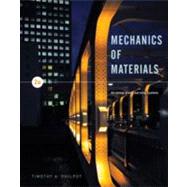
1.1 Introduction.
1.2 Normal Stress Under Axial Loading.
1.3 Direct Shear Stress.
1.4 Bearing Stress.
1.5 Stresses on Inclined Sections.
1.6 Equality of Shear Stresses on Perpendicular Planes.
Chapter 2 Strain.
2.1 Displacement, Deformation, and the Concept of Strain.
2.2 Normal Strain.
2.3 Shear Strain.
2.4 Thermal Strain.
Chapter 3 Mechanical Properties of Materials.
3.1 The Tension Test.
3.2 The Stress-Strain Diagram.
3.3 Hooke’s Law.
3.4 Poisson’s Ratio.
Chapter 4 Design Concepts.
4.1 Introduction.
4.2 Types of Loads.
4.3 Safety.
4.4 Allowable Stress Design.
4.5 Load and Resistance Factor Design.
Chapter 5. Axial Deformation.
5.1 Introduction.
5.2 Saint-Venant’s Principle.
5.3 Deformations in Axially Loaded Bars.
5.4 Deformations in a System of Axially Loaded Bars.
5.5 Statically Indeterminate Axially Loaded Members.
5.6 Thermal Effects on Axial Deformation.
5.7 Stress Concentrations.
Chapter 6 Torsion.
6.1 Introduction.
6.2 Torsional Shear Strain.
6.3 Torsional Shear Stress.
6.4 Stresses on Oblique Planes.
6.5 Torsional Deformations.
6.6 Torsion Sign Conventions.
6.7 Gears in Torsion Assemblies.
6.8 Power Transmission.
6.9 Statically Indeterminate Torsion Members.
6.10 Stress Concentrations in Circular Shafts Under Torsional Loadings.
6.11 Torsion of Noncircular Sections.
6.12 Torsion of Thin-Walled Tubes: Shear Flow.
Chapter 7 Equilibrium of Beams.
7.1 Introduction.
7.2 Shear and Moment in Beams.
7.3 Graphical Method for Constructing Shear and Moment Diagrams.
7.4 Discontinuity Functions to Represent Load, Shear, and Moment.
Chapter 8 Bending.
8.1 Introduction.
8.2 Flexural Strains.
8.3 Normal Strains in Beams.
8.4 Analysis of Bending Stresses in Beams.
8.5 Introductory Beam Design for Strength.
8.6 Flexural Stresses in Beams of Two Materials.
8.7 Bending Due to Eccentric Axial Load.
8.8 Unsymmetric Bending.
8.9 Stress Concentrations Under Flexural Loadings.
Chapter 9 Shear Stress in Beams.
9.1 Introduction.
9.2 Resultant Forces Produced by Bending Stresses.
9.3 The Shear Stress Formula.
9 .4 The First Moment of Area Q.
9.5 Shear Stresses in Beams of Rectangular Cross Section.
9.6 Shear Stresses in Beams of Circular Cross Section.
9.7 Shear Stresses in Webs of Flanged Beams.
9.8 Shear Flow in Built-Up Members.
Chapter 10 Beam Deflections.
10.1 Introduction.
10.2 Moment-Curvature Relationship.
10.3 The Differential Equation of the Elastic Curve.
10.4 Deflections by Integration of a Moment Equation.
10.5 Deflections by Integration of Shear-Force or Load Equations.
10.6 Deflections Using Discontinuity Functions.
10.7 Method of Superposition.
Chapter 11 Statically Indeterminate Beams.
11.1 Introduction.
11.2 Types of Statically Indeterminate Beams.
11.3 The Integration Method.
11.4 Use of Discontinuity Functions for Statically Indeterminate Beams.
11.5 The Superposition Method.
Chapter 12 Stress Transformations.
12.1 Introduction.
12.2 Stress at a General Point in an Arbitrarily Loaded Body.
12.3 Equilibrium of the Stress Element.
12.4 Two-Dimensional or Plane Stress.
12.5 Generating the Stress Element.
12.6 Equilibrium Method for Plane Stress Transformation.
12.7General Equations of Plane Stress Transformation.
12.8 Principal Stresses and Maximum Shear Stress.
12.9 Presentation of Stress Transformation Results.
12.10 Mohr’s Circle for Plane Stress.
12.11 General State of Stress at a Point.
Chapter 13 Strain Transformations.
13.1 Introduction.
13.2 Two-Dimensional or Plane Strain.
13.3 Transformation Equations for Plane Strain.
13.4 Principal Strains and Maximum Shearing Strain.
13.5 Presentation of Strain Transformation Results.
13.6 Mohr’s Circle for Plane Strain.
13.7 Strain Measurement and Strain Rosettes.
13.8 Generalized Hooke’s Law for Isotropic Materials.
Chapter 14 Thin-Walled Pressure Vessels.
14.1 Introduction.
14.2 Spherical Pressure Vessels.
14.3 Cylindrical Pressure Vessels.
14.4 Strains in Pressure Vessels.
Chapter 15 Combined Loads.
15.1 Introduction.
15.2 Combined Axial and Torsional Loads.
15.3 Principal Stresses in a Flexural Member.
15.4 General Combined Loadings.
15.5 Theories of Failure.
Chapter 16 Columns.
16.1 Introduction.
16.2 Buckling of Pin-Ended Columns.
16.3 The Effect of End Conditions on Column Buckling.
16.4 The Secant Formula.
16.5 Empirical Column Formulas—Centric Loading.
16.6 Eccentrically Loaded Columns.
Appendix A Geometric Properties of an Area.
A.1 Centroid of an Area.
A.2 Moment of Inertia for an Area.
A.3 Product of Inertia for an Area.
A.4 Principal Moment of Inertia.
A.5 Mohr’s Circle for Principal Moments of Inertia.
Appendix B Geometric Properties of Structural Steel Shapes.
Appendix C Table of Beam Slopes and Deflections.
Appendix D Average Properties of Selected Materials.
Answers to Odd Numbered Problems.
Index.
The New copy of this book will include any supplemental materials advertised. Please check the title of the book to determine if it should include any access cards, study guides, lab manuals, CDs, etc.
The Used, Rental and eBook copies of this book are not guaranteed to include any supplemental materials. Typically, only the book itself is included. This is true even if the title states it includes any access cards, study guides, lab manuals, CDs, etc.